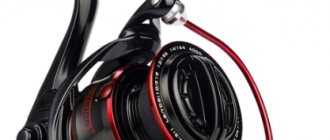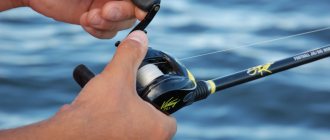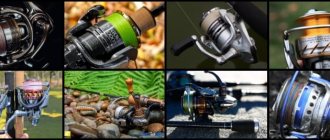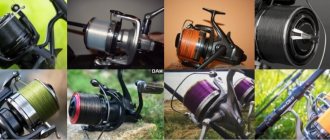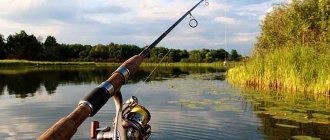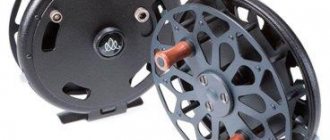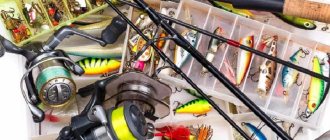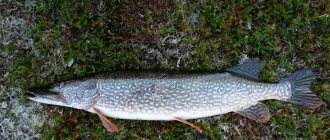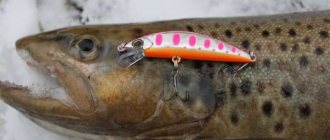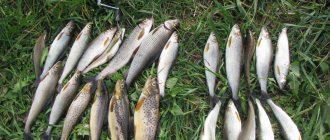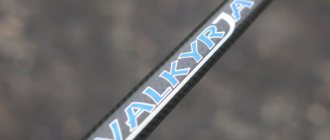Katushka dlya trollinga
Trolling is a special way of catching fish from a moving craft. During such fishing, aggressive predatory fish bite on the towed bait. Therefore, in order to end up with a catch and intact gear, it is important to approach the selection of equipment with the utmost seriousness. And one of the most important elements for successful fishing is the trolling reel.
- 1 Specifications
- 2 Types 2.1 Multiplier
- 2.2 Inertialess
- 5.1 Best multiplier models
Specifications
When choosing and purchasing a trolling reel, you need to clarify several key technical properties and characteristics of the products. Thus, the ability to quickly remove and replace the spool when the fishing line breaks is extremely important. If it is necessary to carry out a large number of manipulations, there is a high risk of missing predatory fish.
The ease of rotation of the reel and good laying of the line during the reeling process also play a big role. Sticking of the reel when turning the handle, or loose thread placement can lead to breaks and loss of catch.
What does a trolling reel look like?
The spool should accommodate a line length of 200-1000 m. But at the same time, low weight is important for the reel. Therefore, the material from which it is made is extremely important.
Rules for using a reel when trolling
- Always check the tightness of the connection between the reel and the rod.
- Do not use baits that do not match the specifications of the reel. This will lead to its rapid breakdown.
- Use only the diameters of cords and lines specified by the reel manufacturer. Otherwise, you will not be able to avoid breakages and beards.
- Set the friction brake accurately, the success of fishing and the performance of the reel itself depend on it. A poorly adjusted clutch will prevent you from hooking correctly. If you overtighten it, then when biting or hooking, the bait may break, the rod or the reel itself may break.
- If the reel is equipped with a reduction gear, use it for landing large fish. This will significantly increase the service life and will help cope even with a shark.
- Keep the reel free of water and sand. This mixture forms an abrasive that can instantly render mechanisms unusable.
- Store and carry the reel in a special case. This will help prevent dirt, dust, water and sand from entering.
By following these simple rules, the reel will delight you with its trouble-free operation for many years, and fishing will bring only positive emotions.
Kinds
The following types of reels can be used for trolling fishing:
- Multiplier;
- Spinning, or inertia-free. In common parlance, such designs are called meat grinders due to the need for long and active cranking of the handle in the process of pulling the fishing line.
In some cases, inertial reels can also be used for trolling fishing. The most suitable and durable product of this type is the Soviet Nevskaya design. It has a high line release speed and is also equipped with a good ratchet.
A glider reel is also used for trolling. This product is a large size inertial reel equipped with good braking hold. This ensures high-quality and simple line release adjustment. Such gear can be secured to the targa or along the side of the craft. The location of the glider reel depends on the design of the boat.
Planer reels for trolling are not only mechanical, but also electric. This design is very convenient for fishing, but it is expensive. To equip an electric glider reel, a specialized cord or fishing line is installed on it, the diameter of which is 1.5-2 mm. In this case, the minimum amount of cord of this type wound onto a reel should be from 5 m.
Multiplier
Multiplier-type trolling reels are a modern, improved version of the inertial design. In terms of its functional features, the multiplier is a high-tech version of the winch, capable of working in extremely difficult conditions and undergoing increased loads.
Main characteristics of baitcasting reels
Power
This value determines what maximum loads the mechanism can withstand. If you neglect this indicator when selecting spinning tackle, then with a high degree of probability you can not only be left without the long-awaited trophy, but even lose the reel itself.
The multiplier reel operates on the principle of a winch. The spool is connected to the handle using a gearbox. The ratio of the number of turns of the handle to the number of turns of the spool itself is the gear ratio. It is used to judge the characteristics of power or speed. For example, with trolling models, as a rule, power characteristics come to the fore. Such reels have a gear ratio of no more than 4.8:1 (but there are exceptions).
Brake system
Main brake.
An axial mechanical brake is usually installed near the reel handle. It literally “tightens” the spool by a few millimeters. However, this is enough to adjust the desired speed of its rotation. The more the mechanism is tightened, the less likely there will be a rush. However, this also reduces the possible casting distance.
Additional brakes (and there may be two of them) allow you to reduce the speed at which the spool rotates directly during the casting process.
- Magnetic system. From the name it’s easy to guess that it regulates rotation using magnetic impulses (without touching the spool). The effect of such a system is more obvious at low or medium speeds. Therefore, multipliers equipped with a magnetic brake are suitable for fishing with compact baits, including jigs.
- The centrifugal system is activated at high spool rotation speeds. The higher the speed, the more actively this brake works. Therefore, it is believed that such a mechanism is more convenient when using sailing baits. For example, a light wobbler will initially fly slower than a heavy jerk (or a minnow with a movable weight system for long casts). Therefore, the spool rotates more slowly, and the centrifugal brake slows it down less. As a result, sailing baits can be cast over a longer distance.
The described conditions for using brake systems should not be taken as a hard and fast rule. The magnetic brake is also suitable for sailing wobblers. The main thing is to choose the right system settings. There are models of multipliers that have both types of auxiliary brakes.
Multiplier line layer
In a multiplier reel, the line guide can be switchable or non-switchable. It is located on an endless worm screw and promotes more uniform winding of the fishing line (cord).
- The non-switchable line guide moves synchronously with the rotation of the spool. It is more reliable and is more often used in “barrels”. Suitable for jerk and heavy jigs. However, it may reduce casting distance.
- The switchable line guide is stationary during casting. Typically used in low profile reels. It will be more convenient when using light or medium-weight baits.
The material from which the line guide eye is made matters. It can be wire or ceramic. The first one is more suitable for monofilament. The second - more durable - is for braided cord. Ceramics can withstand the load from constant friction longer.
This is interesting: The best spinning rod for twitching
Basic requirements for parameters
Regardless of the cost and type of design, a trolling reel must have certain technical parameters:
- Strength and wear resistance of the product. This parameter is extremely important, since during trolling the reel experiences increased loads. The best option would be a product made of metal;
- Smooth brake operation. Timely actuation of the brake allows you to instantly hook fish;
- High speed of line release. This parameter is important because fish will not bite the bait near the watercraft. Therefore, when deep-sea trolling, the line release distance can be up to 50 m, and in shallow water within 5-20 m;
- Volume spool. For a trolling reel, it must hold at least 200 m of fishing line. For active fishing, this is enough for one full season. However, for such a volume of thread in a trolling reel it is only suitable for river fishing. Catching predators in the sea involves reeling up to 1 km. In this case, the maximum load that the reel can withstand should start from 10 kg;
- Line layer with bearing. This design will provide protection against tangling of the fishing line.
Top mid-segment trolling reels
• Abu Garcia BG 10000i
: baitcasting reel for big game fishing, equipped with smooth Carbon Matrix drag system. The spool is metal without perforation. Weight – 815 g, maximum load – 9 5 g, forest capacity – 0.45 mm/430 m, speed ratio – 4.2:1.
• Stinger PowerAge Boat 40R
: reel for trolling and sea fishing. It is a durable graphite body that can withstand heavy loads. The internal mechanism consists of four bearings, the braking system consists of carbon discs. Weight – 610 g, forest capacity – 0.45 mm/450 m, maximum load – 15 kg, gear ratio – 7.1:1.
• Salmo Diamond TROLL 5
: baitcasting reel equipped with a line counter. Can be used in fresh and salt water. The body is reinforced with metal rings. The power mechanism is activated by turning the handle. Weight – 534 g, forest capacity – 0.40 mm/420 m, speed ratio – 4.2:1.
• Black Side Retractor 340
: A power baitcasting reel that is used in fresh and salt water. The powerful internal mechanism is equipped with a gear drive. All parts are protected from corrosion. The maximum load reaches 18 kg. Weight – 640 g, forest capacity – 0.2 mm/430 m, speed ratio – 4.1:1.
• Mikado Baltic Cod ALCV 30 left handle
: A power baitcasting reel designed for heavy trolling. The spool is machined from duralumin. The line layer is installed on a mechanism with a worm gear. Weight – 661 g, forest capacity – 0.4 mm/420 m, speed ratio – 6.2:1.
Criterias of choice
The criteria used to select a trolling reel are largely individual. They depend on the habits and priorities of the fisherman himself, as well as his trolling technique and the type of predatory fish that he plans to catch. In general, when choosing a reel for trolling, special attention is always paid to the following qualities of the product:
- Small design size;
- High strength indicators of the material from which the reel is made, as well as its moving elements;
- Ease of use. To successfully catch fish using the trolling method, it is important for the fisherman to make a minimum of movements before and during manipulations with gear. First of all, this is important for fishermen who go out alone and independently control the vessel during trolling.
The trolling reel must be strong enough.
An important nuance when choosing a reel is the side where the handle is placed. Because a fisherman often has to combine fishing with operating a boat. Therefore, the choice of side for placing the handle depends on which hand you have to hold on to the steering wheel. So, for left-handers it is usually more convenient to use right-handed coils, and for right-handers - left-handed.
One of the important additions to the reel is the line meter. It allows you to determine the exact horizon in which successful fishing is carried out, and quickly bring the bait to it again.
Adviсe
- Perform visual inspections of the coil regularly. Sometimes it helps to identify and prevent serious problems. This may be a lack of lubrication on the gears, which will lead to rapid wear. The presence of water and sand on the mechanisms, which will damage the gear teeth. Loose screws or hexagons that may completely fall apart.
- Carry out maintenance in a timely manner. Use lubricants and cleaning agents recommended by the manufacturer.
- Fine-tune the friction brake taking into account the bottom topography and current so that you don’t have to constantly make adjustments as you go fishing. But don't overdo it by trying to apply more braking force. Follow the rule of the “golden” mean.
- Carefully study the characteristics and instructions of the reel before using it in order to take full advantage of all its advantages while fishing. Or, conversely, do not perform actions that lead to its damage.
- Use cords or lines designed specifically for your trolling reel. This usually concerns the thickness of the material and its type. These parameters are indicated on the coil itself and in the manufacturer's instructions.
- Work only with the weights and types of baits that the reels are designed for.
- Do not try to unify the tackle and use a low-profile baitcasting reel or a high-speed inertia-free one. They will most likely become unusable very quickly. Ruin both the gear and the mood.
- Take care of the safety of the coil during transportation, this is especially important given the high cost.
- Try not to skimp on the reel. It is not necessary to immediately take the most expensive one; there are many budget models that meet all the requirements. The main thing is the quality of materials and production technology.
Rating of the best trolling reels
Selecting a specific coil operating mechanism. multiplier or non-inertia, in most cases it is based on the personal preferences of the fisherman. Therefore, when determining the best reel for trolling, it is important to compare these types of designs separately.
The best cartoon models
The best baitcasting reel models for trolling include:
- Abu Garcia with the Ambassadeur range.
- Shimano Tekota.
- Penn Levelwind.
- Salmo Elite Troll.
- Daiwa Luna.
Pros and cons of baitcasting reels
Like other types of fishing reels, the multiplier has its advantages and disadvantages.
The advantages include:
- more sensitive;
- has less weight and dimensions than inertialess ones;
- does not twist the braid when winding;
- simple and reliable design;
- greater power reserve than inertialess reels of the same parameters;
- casting distance does not depend on the diameter of the braid;
- less dangerous when casting heavy baits.
Minuses:
- more difficult to master for beginners in spinning fishing;
- Constant adjustment of the braking system is necessary depending on the weight of the baits used.
